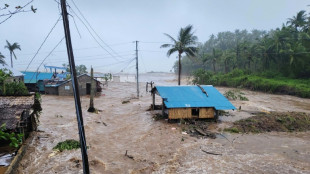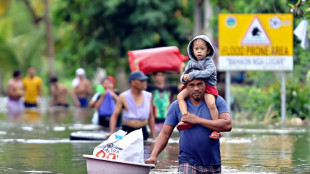

Philippines digs out from Typhoon Fung-wong as death toll climbs
Rescuers using backhoes and chainsaws began digging the Philippines out from the devastation of Typhoon Fung-wong on Tuesday, as floodwaters receded in hundreds of villages and the storm's death toll climbed to 25.
Fung-wong, which displaced 1.4 million people, had weakened into a severe tropical storm even as it began dumping rain on neighbouring Taiwan ahead of an expected Wednesday landfall.
It was the second major typhoon to hit the Philippines in days, after Typhoon Kalmaegi last week rampaged through the archipelago's central islands on its way to killing 232 people, according to the latest figures.
In coastal Isabela province, a town of 6,000 remained cut off from help on Tuesday, a civil defence spokesman told AFP, with parts of neighbouring Nueva Vizcaya province similarly isolated.
"We are struggling to access these areas," said Cagayan Valley region spokesman Alvin Ayson, who added that landslides had prevented rescuers from reaching affected residents.
Others were "now in evacuation centres, but when they get back to their homes, their rebuilding will take time and face challenges", he said.
A 10-year-old boy had been killed by one of the landslides in Nueva Vizcaya, the spokesman added.
The child was among 25 deaths recorded in an updated toll released Tuesday by national civil defence deputy administrator Rafaelito Alejandro, who said many of those killed had died in landslides.
Nineteen of the deaths were recorded in the country's Cordillera mountain range.
- 'So tired' -
In an earlier phone interview, Alejandro told AFP that even "early recovery" efforts would take weeks.
"The greatest challenge for us right now is the restoration of lifelines, road clearing, and restoration of power and communication lines, but we are working on it."
In hardest-hit Catanduanes island, issues with the water supply could take up to 20 days to fix, he said.
Jossa Floranza, a resident of the island's Virac town, told AFP that another typhoon had already forced her to move neighbourhoods, only to see her new home destroyed as well.
"We thought we were safe here," the 34-year-old said, adding the family was driving 20 minutes by motorbike to get water from a nearby river.
"My neighbours said this was the first time that they experienced flooding in this area," Floranza said. "I am very tired of this. So tired."
Up to 400 millimetres (nearly 16 inches) of rain is expected over the next 24 hours, government and weather officials said.
President Lai Ching-te urged people to avoid mountainous areas, beaches and "other dangerous locations" to "get through this period safely".
- 'Strongest typhoon' -
In Cagayan, part of the Philippines' largest river basin, provincial rescue chief Rueli Rapsing told AFP on Monday that a flash flood in a neighbouring province had caused the Chico River to burst its banks, sending residents scrambling to their roofs.
On Tuesday, an AFP journalist rode with rescuers using boats to navigate streets flooded chest deep to pick up those still trapped.
"The water level here at Centro 4 village is rising," a Cagayan information officer in another boat said in a video posted to Facebook.
"There are residents still in the upper floors of multi-storey houses," he said without giving his name.
The day before, 24-year-old Mark Lamer of Cagayan's Tuao town told AFP it was the "strongest typhoon I have ever experienced".
"We didn't think the water would reach us. It had never risen this high previously," he said.
More than 5,000 people were safely evacuated before the overflowing Cagayan River buried the small city of Tuguegarao about 30 kilometres (20 miles) away.
Scientists warn that storms are becoming more powerful due to human-driven climate change. Warmer oceans allow typhoons to strengthen rapidly and a warmer atmosphere holds more moisture, which means heavier rainfall.
Typhoon Kalmaegi last week sent floods rushing through the towns and cities of the central Philippines, sweeping away cars, riverside shanties and shipping containers.
President Ferdinand Marcos said Monday that a "state of national calamity" declared over Kalmaegi would be extended to a full year.
Y.Herrera--GM



